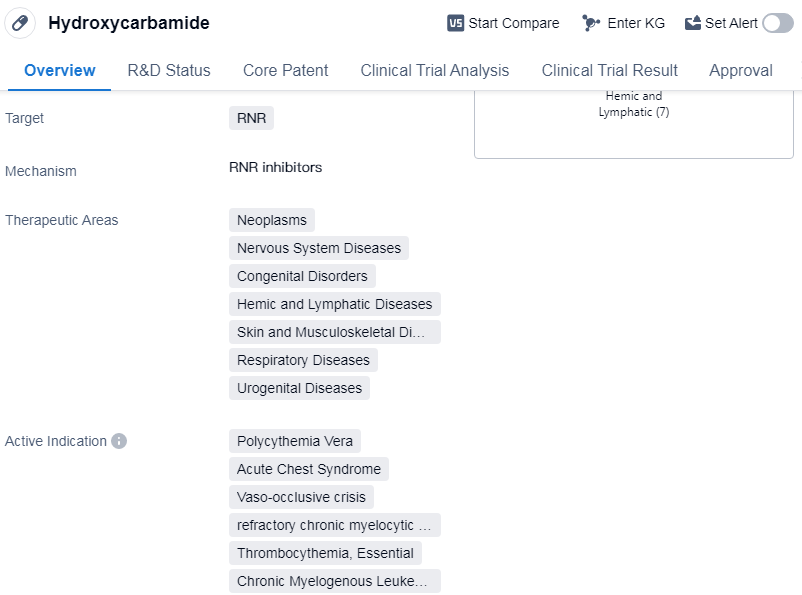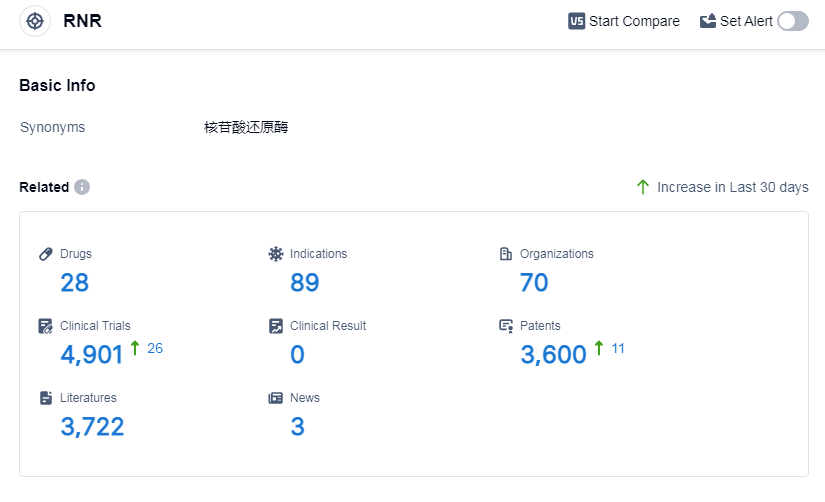An In-depth Analysis of Hydroxycarbamide's R&D Progress and Mechanism of Action on Drug Target
Hydroxycarbamide's R&D Progress
Hydroxycarbamide is a small molecule drug that primarily targets the enzyme ribonucleotide reductase (RNR). It has been approved for use in neoplasms, nervous system diseases, congenital disorders, respiratory diseases, urogenital diseases, etc.
The drug has shown efficacy in treating several conditions. It is commonly used to manage polycythemia vera, a rare blood disorder characterized by the overproduction of red blood cells. Hydroxycarbamide is also indicated for the treatment of acute chest syndrome and vaso-occlusive crisis, both of which are complications of sickle cell disease. Additionally, it has been used in refractory chronic myelocytic leukemia, thrombocythemia essential, chronic myelogenous leukemia, head and neck neoplasms, kidney neoplasms, etc.
Hydroxycarbamide was first approved in the United States in December 1967 and is regulated as an orphan drug, which is granted to medications that are intended to treat rare diseases or conditions.
Hydroxycarbamide was originally developed by Bristol Myers Squibb Co., a renowned pharmaceutical company. It has achieved the highest phase of approval globally, indicating its established safety and efficacy profile.
👇Please click on the image below to directly access the latest data (R&D Status | Core Patent | Clinical Trial | Approval status in Global countries) of this drug.
Mechanism of Action for Hydroxycarbamide: RNR inhibitors
RNR inhibitors are a class of drugs that target the enzyme ribonucleotide reductase (RNR). Ribonucleotide reductase is an essential enzyme involved in the synthesis of DNA, which is necessary for cell division and proliferation. RNR inhibitors work by blocking the activity of this enzyme, thereby inhibiting the production of DNA.
From a biomedical perspective, RNR inhibitors have been studied and developed as potential anticancer agents. Cancer cells often have increased DNA synthesis and replication demands, making them more dependent on the activity of ribonucleotide reductase. By inhibiting RNR, these inhibitors can selectively target and disrupt the growth of cancer cells.
RNR inhibitors have shown promise in the treatment of various types of cancer, including leukemia, lymphoma, and solid tumors. They can be used as standalone therapies or in combination with other anticancer drugs.
However, like any medication, RNR inhibitors may have side effects, and their use should be carefully monitored by healthcare professionals.These inhibitors can target different subunits or cofactors of the enzyme, leading to diverse effects on DNA synthesis and cell proliferation.
Drug Target R&D Trends for Hydroxycarbamide
According to Patsnap Synapse, as of 9 Sep 2023, there are a total of 28 RNR drugs worldwide, from 70 organizations, covering 89 indications, and conducting 4901 clinical trials.
The current competitive landscape of the target RNR shows that multiple companies are actively involved in the research and development of drugs. Sanofi, Clinigen Ltd., Johnson & Johnson, Eli Lilly & Co., Merck KGaA, and Bayer AG are some of the companies with drugs in the approved stage. The highest stage of development for the target RNR is the approved stage, indicating successful research and development efforts. The drugs under the target RNR have been approved for various indications, including lymphoma, chronic myelogenous leukemia, and thrombocytopenia. Small molecule drugs are progressing most rapidly, followed by oncolytic viruses, aptamer drug conjugates, and antisense oligonucleotides. The United States, Japan, and China are the countries developing fastest under the target RNR, with significant progress in drug development. Overall, the target RNR presents a competitive landscape with global development efforts.
👇Please click on the picture link below for free registration or log in directly if you have a freemium account, you can browse the latest research progress on drugs, indications, organizations, clinical trials, clinical results, and drug patents related to this target
Conclusion
In summary, Hydroxycarbamide is a small molecule drug that targets RNR and has been approved for neoplasms, nervous system diseases, congenital disorders, hemic and lymphatic diseases, skin and musculoskeletal diseases, etc. It is primarily used to treat conditions such as polycythemia vera, acute chest syndrome, vaso-occlusive crisis, and various types of cancer. The drug was first approved in the United States in 1967 and is regulated as an orphan drug. Bristol Myers Squibb Co. is the originator of this medication.






